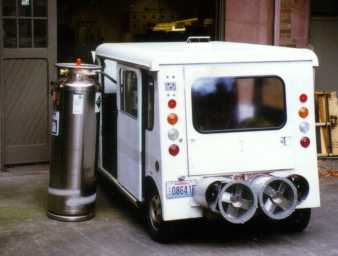Liquid Nitrogen is the cheapest, widely produced and most common cryogenic liquid. It is mass produced in air liquefaction plants. The liquefaction process is very simple in it normal, atmospheric air is passed through a dust precipitator and pre-cooled using conventional refrigeration techniques. It is then compressed inside large turbo pumps to about 100 atmospheres. Once the air has reached 100 atmospheres and has been cooled to room temperature it is allowed to expand rapidly through a nozzle into an insulted chamber. By running several cycles the temperate of the chamber reaches low enough temperatures the air entering it starts to liquefy. Liquid nitrogen is removed from the chamber by fractional distillation and is stored inside well-insulated Dewar flasks. The process to manufacture liquid nitrogen in large quantities can be environmentally very friendly, even if fossil fuels are used to generate the electric power required. The exhaust gases produced by burning fossil fuels in a power plant contain not only carbon dioxide and gaseous pollutants, but also all the nitrogen from the air used in the combustion. By feeding these exhaust gases to the nitrogen liquefaction plant, the carbon dioxide and other undesirable products of combustion can be condensed and separated in the process of chilling the nitrogen, and thus no pollutants need be released to the atmosphere by the power plant. The sequestered carbon dioxide and pollutants could be injected into depleted gas and oil wells, deep mine shafts, deep ocean subduction zones, and other repositories from which they will not diffuse back into the atmosphere, or they could be chemically processed into useful or inert substances. Consequently, the implementation of a large fleet of liquid nitrogen vehicles could have much greater environmental benefits than just reducing urban air pollution as desired by current zero-emission vehicle mandates.
LN2000
The UW
vehicle-dubbed LN2000 works like a steam engine, except it is powered by
vaporizing very cold liquid nitrogen instead of steam from boiling water. The
nitrogen vapor turns an air motor to propel the car and then exits the
tailpipe. Since the atmosphere already is 78 percent nitrogen, the
environmental effect of driving LN2000 vehicles-even millions of them-would be
virtually undetectable.
The
LN2000's heat exchanger pulls liquid nitrogen from an insulated fuel tank
through a series of aluminum tubing coils and specially designed pipes. Engine
exhaust and outside air are circulated around the coils and pipes to gradually
warm up the nitrogen from a minus 320 F liquid to an ambient-temperature gas.
The heat
exchanger is like the radiator of a car, but it acts in the opposite way.
Instead of using air to cool water, it uses air to boil liquid nitrogen into
nitrogen gas.
The
conversion from liquid to gas expands the volume of the nitrogen 700 times,
building sufficient pressure to turn an air motor much like pressure from
burning gasoline drives an internal combustion engine.
With a
$360,000 U.S. department of energy grant, UW researchers and students have
built a LN2000 prototype from a converted Grumman Kubvan mail truck. Aside from
the Husky decals, the vehicle looks much like any other postal truck on the
outside. But open up the back and one finds insulated tanks, piping, hoses and
gauges more befitting a research laboratory than an automobile. Under the hood
is a 15 horsepower air motor originally designed to power a winch for raising
ship anchor. And instead of generating plumes of foul exhaust, the LN2000 emits
cold nitrogen gas which freezes water vapor in the air to form small clouds
behind the vehicle.
While the
reliance of internal combustion engines on non-renewable fuels has prompted
automotive engineers to make car motors more efficient over the years, air
motors have had the luxury of remaining fabulously inefficient. As a result,
the motor used in the LN2000 prototype gives gas guzzling new meaning by consuming
about five gallons of nitrogen fuel per mile. Plus it musters a top speed of
only 22 M.P.H. and chugs laboriously up hills.
Future
scope
There is
research going on to design a more efficient motor that could achieve top
speeds of 60 m.p.h. and two to three miles per gallon in an optimally designed
vehicle. This would enable the LN2000, using a 100-gallon tank, to match the
average range for gas-powered vehicles of 250 miles between fill-ups. As large
as the 100-gallon tank sounds, it would still weigh less and take up less space
than the batteries used in electric cars.
The liquid
nitrogen vehicle also has the potential to be more economical to operate than
electric vehicles, according to the UW researchers. Assuming a
10-cent-per-gallon price for mass-produced liquid nitrogen, they predict the
LN2000 would cost about 4 cents per mile to drive compared with an estimated 7
cents-per-mile cost of driving electric cars (including the cost of battery
replacement every two to three years).
Another
advantage for liquid nitrogen cars is that they don't require a new
infrastructure for mass utilization. Today's filling stations can easily be
converted to dispense liquid nitrogen instead of gasoline. And users will be
able to fill up in minutes rather than the 4-6 hours required to fully recharge
an electric car battery.


Think a Stirling Engine could be used in this concept where the cold end of the engine is chilled with the LN2 and the heat from the ambient air is use to make the engine function?
ReplyDelete